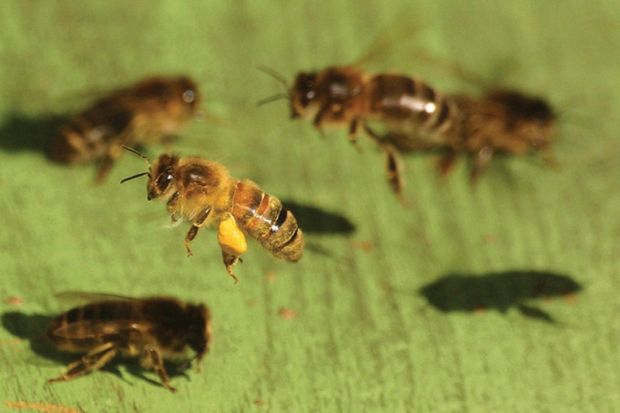Aristotle knew that bees were remarkable creatures. The Austrian scientist Karl von Frisch (1886-1982), whose story Tania Munz tells in this absorbing book, identified and explained some of their most fascinating behaviours. Von Frisch was a gifted, inventive and rigorous experimenter who was also very interested in communicating his findings to a wider public.
His first significant research concerned colour vision, starting with fish but soon moving on to honeybees. Elegant experiments showed that bees could distinguish green, blue and yellow, but not red. In 1917, he noticed that a bee that had found a rich source of food seemed able to communicate its whereabouts to its hive-mates. Later, using a special glass hive, von Frisch observed something “delightful and riveting”. On returning from feeding, some bees performed one of two manoeuvres, which von Frisch called the circle and the waggle dances. Understanding these dances would occupy much of the rest of his life.
In February 1941, when von Frisch was based in Munich, his future was put in jeopardy when he was informed by the Reich that he was one-quarter Jewish. Even though his maternal grandmother’s parents had converted to Christianity before her birth, his maternal grandmother was deemed a Jew. Von Frisch had never thought himself Jewish, but now he faced expulsion from his research institute, although initially little worse threatened. He responded by enlisting readily forthcoming support from influential colleagues and by refocusing his research. German bees, which were vital to the Fatherland’s food supply, were suffering from nosema, a fungal parasite. Von Frisch started research towards finding a cure for nosema disease and, although he had little success, the threat to his position was lifted in July 1942.
A far greater potential danger to von Frisch’s life and research was Allied bombing, which in July 1944 destroyed his zoological institute at the University of Munich. He responded by moving to his summer home, Brunnwinkl in rural Austria, and the next two years resulted in his most productive and ground-breaking work. He showed that, contrary to his earlier interpretation, the waggle dances of the forager bees give other bees precise information on the direction of and distance to food sources. Of this discovery, which argued for a highly sophisticated degree of communication between the bees, he wrote to a friend, “If you think I’m crazy, you’d be wrong. But I could certainly understand it.”
In 1967, after 20 years in which von Frisch’s work received general acceptance, serious attacks were launched on his interpretation of the dance language. Adrian Wenner, a California-based biologist, led the charge, claiming that bees’ waggle dances were not food-directing. Munz argues that von Frisch’s interpretation has survived largely intact, while showing that the debate reflected deep contemporary theoretical tensions in biology, with Wenner the representative of a behaviourist approach historically dominant in the US.
This is a concise, well-written account of an important scientific life – von Frisch shared the Nobel Prize in Physiology or Medicine in 1973 – that places him deftly in his historical context. Of his life outside science, we learn only that his one regular holiday was his wife Margarete’s birthday and that he once played regularly in a string quartet. For me, a zoological novice, Munz’s account is a gripping, informative read.
Richard Joyner is emeritus professor of chemistry, Nottingham Trent University.
The Dancing Bees and the Discovery of the Honeybee Language
By Tania Munz
University of Chicago Press, 296pp, £25.00
ISBN 9780226020860 and 21058 (e-book)
Published 13 June 2016
Register to continue
Why register?
- Registration is free and only takes a moment
- Once registered, you can read 3 articles a month
- Sign up for our newsletter
Subscribe
Or subscribe for unlimited access to:
- Unlimited access to news, views, insights & reviews
- Digital editions
- Digital access to THE’s university and college rankings analysis
Already registered or a current subscriber? Login




